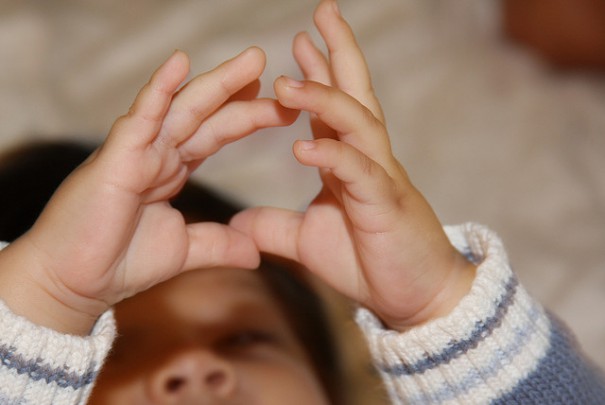Well before they utter their first words, infants as young as six months can learn to sign. Baby sign language is thought to reduce baby’s frustration level, boost self-esteem, and bolster language development. And you don’t need to be an expert. Begin with three to five signs, saying the word as you sign it. Encourage other caregivers and siblings to join in. Then repeat, repeat, repeat. Your little one’s motor skills may not allow her to perfectly mimic the sign, so watch for hand gestures that indicate she’s trying, usually within two months of being introduced to it. Here are some great starter signs.
Photo: ckmck via Flickr
All in the Family
Show your little one the sign for a person he knows, like mommy, daddy, brother, grandma or baby. It doesn’t matter if you plan to use mommy, mama, mother, or mom, the sign is the same — using an open palm with fingers spread, tap your thumb on your chin. For “daddy” and its variations, use the same hand position, only tap the forehead. Remember to point to the person as you sign.
Video: Baby Sign Language.com
Easy as Pie
Food is a great motivator. Teach your little eater the sign for her favorite food or the ones for eat, milk or bottle. When Baby’s plate is empty, “more” and “all done” allow her to set the pace for the meal. To sign “more,” press the thumb and fingertips of each hand together, and then tap the fingertips of the two hands together several times. Look for baby to put his fists or palms together as she starts to get the hang of this sign.
Video: Baby Sign Language.com
Monkey See, Monkey Do
Animal signs are fun because they often mimic some aspect of the animal. Baby will love learning the signs for her beloved pet or for the animals around the neighborhood. Dog, cat, fish and bird are all good candidates. You can even have a favorite stuffed animal act out the motions for its sign. The baby sign for “dog” is patting your hand to your hip, as if calling a dog. This is a slight modification from the American Sign Language version, which includes a snap that is too difficult for emerging motor skills.
Video: Baby Sign Language.com
Mind Your Manners
It’s never too early to introduce your little bundle to being polite. “Please” is a great word to start with. Try this technique when it’s clear he desires something specific, like a toy or a drink, and he’s not upset or in any distress. Say that you will get it and ask if he can say “please,” demonstrating the sign as you do so. Then give him the item, regardless if he does the sign or not. Eventually the concept will begin to sink in and he’ll be doing it on his own. With a flat hand and thumb extended, sign “please” by moving the palm of your hand in a circular motion in front of your chest.
Video: Baby Sign Language.com
The Daily Grind
Use the repetition of baby’s routine as an opportunity to teach her the signs of daily life. Learn “sleep” for naptime and bedtime. Let baby know it’s playtime by signing “play,” and then show her the sign for whatever you are playing with, be it a ball, blocks, or a book. The sign for “bath” mimics the act of washing. To do this sign simply move both your fists up and down in front of the chest as if scrubbing it.
Video: Baby Sign Language.com
Have you tried baby sign language? Share your tips in a comment.
–Katie L. Carroll











